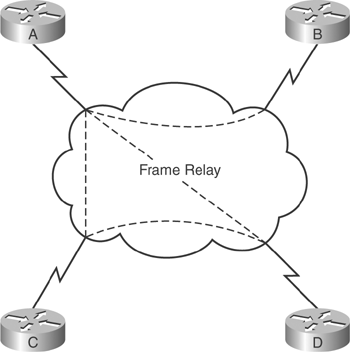Chapter 6. OSPF Network Topologies
This chapter covers the following topics:
OSPF Network Topology Options—Describes the differences between these OSPF network types, the use of subinterfaces, and how to select an OSPF design.
Configuring OSPF in a Nonbroadcast Environment—Describes how to configure different types of OSPF networks.
This chapter details OSPF support for nonbroadcast multiaccess (NBMA) interfaces. Several OSPF network topologies are possible in an NBMA environment. In particular, the various options for configuring OSPF over Frame Relay on Cisco router physical interfaces and subinterfaces are explored. This chapter assumes knowledge of the previous chapter, which introduced OSPF.
The purpose of the "Do I Know This Already?" quiz is to help you decide what parts of this chapter to use. If you already intend to read the entire chapter, you do not necessarily need to answer these questions now.
The 12-question quiz, derived from the major sections in the "Foundation Topics" portion of the chapter, helps you determine how to spend your limited study time.
Table 6-1 outlines the major topics discussed in this chapter and the "Do I Know This Already?" quiz questions that correspond to those topics.
| Foundation Topics Section | Questions Covered in This Section | Score |
|---|---|---|
| OSPF Network Topology Options | 1–11 | |
| Configuring OSPF in a Nonbroadcast Environment | 12 | |
| Total Score |
Caution
The goal of self-assessment is to gauge your mastery of the topics in this chapter. If you do not know the answer to a question or are only partially sure of the answer, you should mark this question wrong for purposes of the self-assessment. Giving yourself credit for an answer you correctly guess skews your self-assessment results and might provide you with a false sense of security.
| 1. | Which of the following is not an OSPF network type?
|
| 2. | What OSPF network type is a workaround used to account for the lack of multicast and broadcast support inherent in the default behavior of Cisco router interfaces in a nonbroadcast environment?
|
| 3. | How often, by default, does OSPF send out hello packets on a broadcast multiaccess link?
|
| 4. | If a router has an OSPF priority set to 0, what does this indicate?
|
| 5. | Which two of the following are valid OSPF network types that do not support DR election?
|
| 6. | True or False: It is possible to create a full mesh environment emulating a broadcast network topology using the NBMA OSPF network type. |
| 7. | RFC 2328 describes the operation of OSPF in two modes across an NBMA cloud. What are they?
|
| 8. | You want to set up a newly created point-to-point subinterface to use the OSPF point-to-point network type. What command should you use?
|
| 9. | Router A has a priority of one, but is configured on Router B with the following command:
RouterB(config-if)# neighbor 12.150.146.3 priority 7What value does Router B use for the priority of Router A?
|
| 10. | Look at Figure 6-1. If this topology were configured with the NBMA OSPF network type, which of the following are true?
Figure 6-1. Sample Topology
|
| 11. | Referring to Figure 6-1, with the point-to-multipoint OSPF network type, which of the following are true about this topology?
|
| 12. | You want to set up an interface to use a DR, but do not want to have to manually identify neighbors. What command should you use?
|
The answers to this quiz are found in Appendix A, "Answers to Chapter 'Do I Know This Already?' Quizzes and Q&A Sections." The suggested choices for your next step are as follows:
- 8 or less overall score—Read the entire chapter. This includes the "Foundation Topics," "Foundation Summary," and "Q&A" sections.
- 9 or 10 overall score—Begin with the "Foundation Summary" section and follow up with the "Q&A" section at the end of the chapter. If you need additional review, read the appropriate sections in "Foundation Topics."
- 11 or 12 overall score—If you want more review on these topics, skip to the "Foundation Summary" section and then go to the "Q&A" section at the end of the chapter. Otherwise, move to the next chapter.








